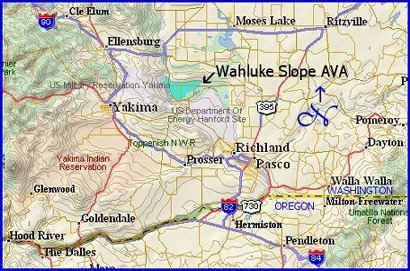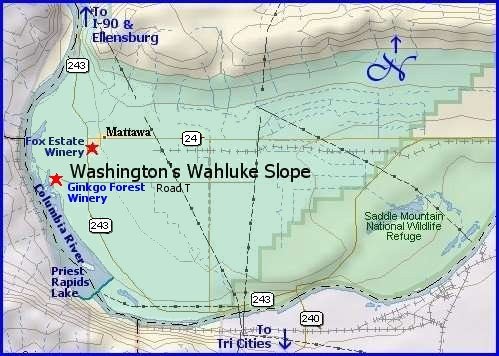|


Wahluke Slope -Washington's eighth
appellation
...its vineyards and its wineries
The
Wahluke Slope appellation was authorized as an official
Washington State appellation in 2006. North of the
Yakima Valley, it is one of the state's warmest growing
regions, and 8,491 acres to date (April, 2017) out of the AVA's 81,000
acre total are planted to a variety of wine grapes,
producing about 20 percent of the entire Washington State
harvest each year.
The Columbia River drifts lazily through the gap in the
Saddle Mountains and curves to form Wahluke Slope's southern
and western boundaries. It is the only appellation in
the Pacific Northwest that is a single geological landform.
The region is a giant alluvial fan created by repetitive
flooding events.

Click on Map for a Closer Look
|
To
print map, RIGHT mouse click over the map & do one of the
following:
INTERNET EXPLORER -
click on the Print Picture option;
FIREFOX - click on View image then choose Print from the
browser pull down menu; or
SAFARI & CHROME - click on Open image in new tab then choose
Print from browser pull down menu. |
Of the four newest Washington appellations within the
Columbia Valley AVA, the Wahluke Slop may hold the most
untapped potential. An 81,000-acre triangular slice of
desolate scrubland, it is nestled above the Columbia River
in south-central Washington and wins high marks for the way
its concentrated heat ripens Merlot and Cabernet Franc.
Much of the appellation was created by The Great Missoula
Floods that exploded through ice dams thousands of years
ago, ripping land and rocks from their paths during the
final stages of the last ice age. Unimaginable volumes
of floodwaters propelled icebergs and boulders across the
Columbia Basin. Locally, floods burst through Sentinel
Gap near Mattawa on the Wahluke Slope, grinding basaltic
lava flows into tiny particles and dumping boulders, some
the size of houses, across the area. Layers of silt
and wind-blown sand form the surface through which
grapevines send their roots. Gravelly, rocky soil,
combined with a dry, warm climate, make Wahluke Slope one of
the best places in Washington to grow wine grapes.
- Wahluke Slope AVA (2006)
81,000 acres; 5,200 in production (at AVA
authorization);
two
wineries; three custom crush facilities. Grant
County, eastern Washington. Totally within the
macro appellation of the Columbia Valley.
Twenty vineyards. One of Washington's warmest
regions. Elevation ranges from 425 feet
along the Columbia River to 1,475 feet atop the
highest irrigated lands.
- Noted for its grapes,
mostly Merlot,
Syrah, Cabernet Sauvignon, Riesling, Chardonnay and
Chenin Blanc; not yet for
its wineries.
- Wineries:
Two wineries currently
operate in the Wahluke Slope AVA -
Fox Estate Winery and
Ginkgo Forest Winery.
Jerry Fox and
his family have been growing wine grapes on their
Fox Estate Vineyard since the early 1980s.
Ginkgo Forest Winery opened its tasting room in 2007;
a second tasting room in Tacoma was opened in July
of 2013. Also operating on the Slope are three
crush facilities. The Millbrandt Family's
Wahluke Wine Company located near Mattawa is a
custom-crush facility where bulk wine is made for
growers and other wineries; it is not open to the
public, but the
Millbrandt's
opened their own winery and tasting room in
Prosser. Coventry Vale, another customer crush
facility, operates a production facility in the far
eastern part of the Slope. It, too, is not
open to the public, nor is the crush facility of
Lost River Winery also operating on Wahluke Slope;
Lost River's
barrel cellar and tasting room is located in
Winthrop, Washington, to the north.
- Wines made with Wahluke
Slope grapes: Grapes grown in this region
are used by wineries throughout the Northwest... far
too many to mention. This partial list will
give you at least an idea of the credibility of the
region and the quality of its grapes: Bergevin
Lane, Chateau Ste Michelle, Chatter Creek, Columbia
Crest, Desert Wind, Duck Pond Cellars
(Oregon), Hogue Cellars, Isenhower Cellars, K
Cellars, Latah Creek, Lost River Winery, Northstar,
Snoqualmie Vineyards, St. Laurent Winery ,
Syncline Wine Cellars, Three Rivers Winery, and
many, many more. Mourvčdre, Primitivo, Malbec, and
Petit Verdot, relatively new varietals to Pacific
Northwest wine regions, are all planted on Wahluke
Slope.
- Some Wahluke Slope vineyards:
- Milbrandt Vineyards
- Lucky Bohemian Farms -
260 acres planted to Merlot, Syrah, Cabernet
Sauvignon and other heat-loving varietals;
- Indian Wells Vineyard - flagship vineyard
for Chateau Ste Michelle;
- Rosebud Vineyard planted by members of the
Dodson family in 1978;
- Fox Estate Vineyard - planted by the Fox
family in the early 80s;
- Stone Tree Vineyard - 450-acre vineyard
planted to clones of Grenache,
- Clifton Vineyard - 500-acre vineyard owned
by the Millbrandt family;
- Desert Wind Vineyard - 540-acre estate
vineyard owned by the same family as owns Duck
Pond Cellars in Oregon;
- Winebau Vineyard - Sagemoor Farms owns this
vineyard;
- Wahluke Slope Vineyard;
- Dick Shaw vineyards;
- Jack Jones vineyards
- Top Grape Varietals:
Merlot, Syrah,
Cabernet Sauvignon, Riesling, Chardonnay, and Chenin
Blanc.
|
A closer look

|
To
print map, RIGHT mouse click over the map and do one of the
following:
Internet Explorer
click on the �Print Picture� option;
Firefox click on View image, then choose Print from the
browser pull down menu; or
Safari and Chrome click on Open image in new tab then
choose Print from browser pull down menu. |
Wahluke Slope Wineries
Fox Estate Winery
(Mon - Fri: 8 - 5pm
Weekends by appointment)
24962 Highway 243 South
(Mile Marker #13)
Mattawa, WA 99349
509-932-5818
Ginkgo Forest Winery
(Apr-Oct: Wed-Sat 10am-5pm,
Sun 1pm-5pm)
22561 Rd T 7
SW
Mattawa, WA 99349
509-932-0082



Copyright ? 2005 -
April, 2017
Susan R. O'Hara. All rights reserved.
Last revised:
04/10/2017
|





